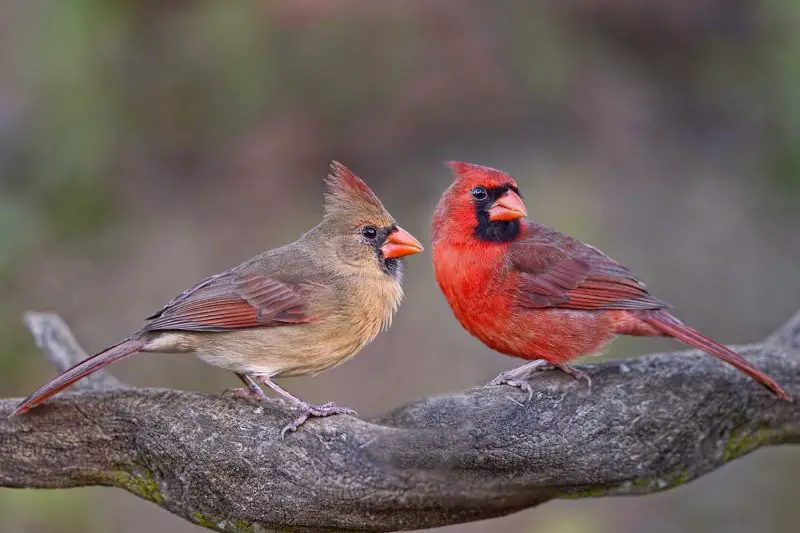The Northern Cardinal (Cardinalis cardinalis) is one of the most recognizable and beloved birds in North America. Known for its brilliant red plumage and cheerful songs, this bird has captured the hearts of birdwatchers for generations. But did you know that male and female cardinals are not identical? While they share many similarities, they also display distinct physical and behavioral traits that make each sex unique.
Understanding these differences is not only fascinating but also helps bird enthusiasts accurately identify cardinals in the wild. From variations in color to differences in song and parenting roles, each detail reveals more about how these birds thrive together.
In this article, we’ll explore the most important differences between male and female cardinals, including their appearance, calls, nesting habits, and more — so you can easily tell them apart next time you spot a pair in your backyard.
Physical Appearance Differences Between Male and Female Cardinals
When most people picture a cardinal, they imagine a bright red bird perched on a snowy branch. However, this vivid red coloration belongs exclusively to the male cardinal. The female cardinal, on the other hand, has a more subtle beauty that often goes unnoticed.
Comparison Table: Male vs. Female Cardinal Traits

Characteristic |
Male Cardinal |
Female Cardinal |
|---|---|---|
Coloration |
Bright crimson red all over |
Soft brown or tan with red highlights |
Facial Mask |
Bold black mask from beak to throat |
Grayish or faint mask |
Beak Color |
Bright orange-red |
Orange-red, slightly lighter |
Body Size |
Slightly larger and more robust |
Slightly smaller and sleeker |
Crest |
Prominent and upright |
Slightly shorter and smoother |
Visibility |
Highly visible in open areas |
More camouflaged in shrubs or nests |
Purpose of Color |
Attract mates, show dominance |
Provide camouflage for nesting |
Male Cardinal Appearance
Male cardinals are instantly recognizable thanks to their brilliant crimson-red plumage that glows in the sunlight. Their feathers are uniformly red across the body, with slightly darker shading around the face and wings. This vibrant color serves as a display of health and strength, signaling to females that the male is a strong potential mate.
They also feature a black mask that extends from their face to their throat, giving them a bold, dramatic look. Their orange-red beak stands out against the black facial markings, adding to their stunning appearance. During the breeding season, males often look even more vibrant, as they molt into their brightest plumage to attract a partner.
Female Cardinal Appearance
Female cardinals are paler and more understated, but no less beautiful. Their feathers are mostly soft tan, buff, or light brown, with subtle reddish tinges on the wings, tail, and crest. This coloration provides excellent camouflage when nesting — a crucial advantage during breeding season.
The female also sports an orange-red beak, similar to the male’s, but her facial mask is grayish or less defined, making her face appear softer and gentler. Despite her muted tones, when sunlight hits her feathers, the reddish highlights shimmer elegantly.
Why the Color Difference Exists
This contrast in color is a result of sexual dimorphism, a natural trait where males and females of the same species exhibit different physical appearances. For cardinals, this difference evolved for survival and reproduction.
The male’s bright red feathers attract females and signal good health, while the female’s duller colors help her remain hidden while incubating eggs. It’s a perfect balance of beauty and practicality that supports the species’ success.
Behavioral Differences Between Male and Female Cardinals
Physical appearance isn’t the only way to distinguish male and female cardinals. Their behavior offers valuable clues as well. Males and females play different roles in courtship, territory defense, and parenting.
Male Cardinal Behavior
Male cardinals are highly territorial and protective. They spend much of the breeding season defending their space from rivals, often attacking their own reflection in windows or mirrors, mistaking it for another male.
They use loud, clear songs and physical displays to mark their territory boundaries. These behaviors ensure that their mate and offspring have access to safe feeding areas.
During courtship, male cardinals often exhibit romantic feeding behavior — delicately offering seeds or insects to the female’s beak. This touching display not only strengthens the pair bond but also demonstrates the male’s ability to provide food for their future chicks.
Female Cardinal Behavior
Female cardinals are more focused on nesting and incubation. Once a mate is chosen, she selects the nest site and builds it almost entirely by herself. The nest is typically made of grasses, twigs, and bark strips, hidden within dense shrubs or trees for protection.
Interestingly, female cardinals also sing — a rare trait among female songbirds. Her song differs slightly from the male’s and is often used to communicate during nesting. For example, she may sing to signal the male to bring food or to alert him to potential dangers near the nest.
Interaction Between the Pair
Cardinals are monogamous, often mating for life. The male and female work closely together throughout the year, especially during breeding. While the female incubates the eggs, the male guards the territory and brings her food. Once the chicks hatch, both parents share feeding duties, showing a remarkable level of cooperation and dedication.
Differences in Songs and Calls
Both male and female cardinals are known for their beautiful, whistling songs that brighten up any backyard. However, their vocalizations are not identical, and each serves a distinct purpose.
Male Cardinal Songs
The male’s song is typically louder, clearer, and more frequent. It’s used primarily for territory defense and mate attraction. Common song patterns include phrases like “cheer-cheer-cheer” or “birdy-birdy-birdy,” repeated several times.
During spring and early summer, males sing from high perches, such as treetops or telephone wires, to announce their presence and deter competitors. Their powerful voice can carry over long distances, making it an effective territorial tool.
Female Cardinal Songs
Female cardinals also sing — a relatively uncommon trait in songbirds. Her song tends to be softer, shorter, and more complex. Females usually sing while hidden in dense vegetation near the nest, often communicating directly with their mate.
Research shows that female cardinals use specific notes to signal their needs — for instance, calling for food or warning of predators. This unique form of vocal coordination between mates helps ensure the safety of their young.
Duet Singing and Communication
Sometimes, male and female cardinals sing duets, especially during the breeding season. These coordinated exchanges strengthen pair bonds and help synchronize nesting activities. Observing these duets can be one of the most fascinating aspects of watching cardinals in the wild.
Nesting and Parental Roles
Another significant difference between male and female cardinals lies in their nesting responsibilities and how they care for their young.
Nest Building
The female cardinal takes the lead in building the nest. She meticulously weaves together twigs, leaves, and grasses to create a sturdy cup-shaped structure. The process usually takes 3 to 9 days, with the male occasionally bringing materials but rarely participating in construction.
The nests are typically built in dense shrubs, low tree branches, or vine tangles, usually 3–10 feet above the ground. The location is chosen carefully to provide both protection from predators and shade for the eggs.
Egg Laying and Incubation
Once the nest is ready, the female lays 2 to 5 eggs, which are whitish with brown or gray speckles. She alone incubates them for about 12 to 13 days, during which time the male remains nearby to defend the area and deliver food.
The female’s more subdued plumage provides camouflage while she sits on the nest, keeping her and the eggs hidden from predators such as snakes and blue jays.
Feeding and Raising the Chicks
After the chicks hatch, both parents become active feeders. They regurgitate insects and seeds into the open mouths of their hungry young, visiting the nest countless times each day.
As the chicks grow and leave the nest (after about 10–11 days), the male often continues feeding them while the female prepares for a second brood. Cardinals typically raise two to three broods per year, depending on conditions.
Territorial and Seasonal Behavior
Cardinals are non-migratory birds, meaning they stay in their territories year-round. However, the way males and females behave within these territories can change with the seasons.
Territorial Behavior in Males
Male cardinals maintain strict territories, especially during the breeding season. They’ll fiercely defend their area from intruding males by singing, chasing, and even physically fighting.
Their reflection in car mirrors or windows often triggers attacks because they mistake it for a rival. This aggressive behavior peaks in spring and early summer but diminishes once nesting is complete.
Female Territorial Behavior
Females are generally less aggressive but remain active within the pair’s territory. They help guard the nest area and stay alert for potential threats. During winter, when food becomes scarce, both males and females may join small flocks for safety and efficiency in foraging.
Seasonal Changes
In winter, the bright red males become even more noticeable against snowy backgrounds. Their vivid color helps them maintain dominance at feeders, but they remain loyal to their mates, often seen foraging together even outside of breeding season.
Diet and Feeding Habits
Male and female cardinals share a similar diet, but their feeding behavior and roles can differ slightly, especially during breeding.
Common Foods
Both sexes eat a wide variety of foods, including seeds, fruits, berries, and insects. Their strong, conical beaks are designed for cracking open sunflower seeds and other tough shells. Insects become especially important during the breeding season, as they provide essential protein for growing chicks.
Feeding Behavior
Male cardinals are often more visible at bird feeders, boldly perching in open areas. Females tend to feed in more concealed spots, staying closer to shrubs or low branches.
During courtship, the male may feed the female directly, a tender behavior that reinforces their bond and prepares them for shared parenting responsibilities.
Seasonal Diet Changes
In winter, cardinals rely heavily on seeds and fruits such as dogwood berries, sumac, and wild grapes. In spring and summer, their diet shifts toward insects like beetles, caterpillars, and grasshoppers. These seasonal adjustments help them meet energy needs and raise healthy broods.
How to Attract Cardinals to Your Yard
If you love watching these beautiful birds, attracting them to your yard is easier than you might think. Cardinals are relatively non-migratory and will happily visit places that provide food, water, and shelter year-round.
Provide the Right Food
Cardinals love sunflower seeds, safflower seeds, cracked corn, and peanuts. Use sturdy platform feeders or large tube feeders with wide perches — cardinals have heavier bodies than most songbirds, so they need space to balance comfortably. Keeping feeders full during winter ensures they return daily.
Offer Fresh Water
A clean birdbath with shallow water is essential. Cardinals enjoy bathing and drinking from gently moving water, so adding a small fountain or dripper will make your yard even more inviting. Refresh the water regularly to prevent bacteria or mosquitoes.
Create Natural Shelter
Dense shrubs, small trees, and evergreen bushes make perfect hiding and nesting spots. Cardinals prefer sheltered, quiet areas with enough cover to feel safe from predators. Plant native vegetation like dogwood, viburnum, or juniper to create an attractive habitat.
Add Berry-Producing Plants
Cardinals love fruit-bearing plants such as serviceberry, mulberry, and winterberry holly. These provide both nutrition and natural cover, especially in colder months when insects are scarce. The more natural food sources you offer, the more likely cardinals will stay year-round.
Interesting Facts About Male and Female Cardinals
They Can Mate for Life
Once cardinals pair up, they often remain together year after year. Many mated pairs return to the same nesting area each spring.
Females Sometimes Sing More Than Males
In some regions, females actually sing more frequently than males, especially during nesting season, highlighting their unique role in communication.
Both Help Feed Their Young
Few songbird species share parenting duties as equally as cardinals do. Both parents tirelessly feed and protect their chicks until they can survive independently.
Their Colors Come from Diet
The male’s red feathers come from carotenoid pigments found in berries and seeds. Without a proper diet, their plumage may fade to dull orange or brown.
They Stay Year-Round
Unlike many migratory birds, cardinals remain in the same general area all year, bringing color and song to even the coldest winter days.
FAQs About Male and Female Cardinals
Do male and female cardinals mate for life?
Yes. Most cardinal pairs remain together for several breeding seasons, often returning to the same territory each year. However, if one mate dies, the survivor may find a new partner.
Can both male and female cardinals sing?
Absolutely. Unlike many songbird species, both sexes sing. Males sing to defend territory, while females often sing to communicate during nesting.
Why do male cardinals attack windows?
Male cardinals are territorial and may see their reflection as another rival male, prompting them to attack. This behavior is most common in spring.
Are female cardinals rare to see?
No, but their brown plumage makes them harder to spot than males. They often stay closer to shrubs or lower branches for better camouflage.
Do female cardinals turn red over time?
No. Female cardinals retain their buff-brown coloration throughout life, though lighting conditions can make them appear more reddish at times.
Conclusion
Male and female cardinals may look different, but together they form one of nature’s most beautiful partnerships. The male’s vivid red plumage and territorial songs balance perfectly with the female’s graceful appearance and nurturing instincts.
By learning to recognize the unique traits of each, you can appreciate these iconic birds on a deeper level — from their fascinating behaviors to their lifelong pair bonds.
So the next time you see a flash of red in your yard, take a closer look. Whether it’s the fiery male or the softly colored female, both are reminders of the beauty and harmony found in nature.






